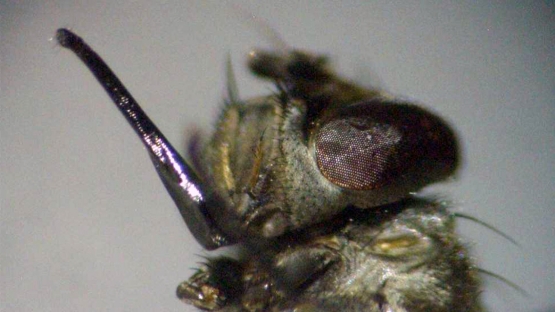Costa Rica’s position as the world’s largest producer of pineapple brings with it a parallel problem for the country’s livestock and dairy industry. Its pineapple processing plants are surrounded by mountains of pineapple residue, and that residue provides a breeding ground for the aggressive, blood-sucking “stable fly”, a fly that can wreak havoc on cattle and affect their productivity. In an effort to control the fly without resorting to chemical sprays, the Costa Rica Institute of Agricultural Technology Research (INTA-MAG) with the support of the Joint FAO/IAEA Division identified another way to do the job – using a wasp. Not just any wasp. This wasp is a “biocontrol agent”, a natural enemy of the stable fly that does no harm to the environment. The extensive experience of the Joint Division in the use of irradiation in biocontrol and in insect mass rearing has made this an ideal partnership.
The stable fly got its name from its habitat. Known scientifically as Stomoxys calcitrans, the stable fly hangs out almost anywhere that horses, cattle and other agricultural animals can be found. A bit smaller than the common housefly, its stinging, blood-sucking bite stresses the dairy and livestock cattle it attacks and can lead to anaemia, weight loss and reduced milk production.
Costa Rica’s dairy and livestock sector has a particular problem with the stable fly because of the country’s position as the world’s largest producer of pineapple. The stable fly lays its eggs in pineapple residue and, when the new flies emerge, they fly off in the direction of the nearest cattle or dairy farm. Efforts to control the stable fly with pesticides can have public health or environmental impacts.
Now, there is a new player in the control game, the Spalangia, a tiny parasitoid wasp. Parasitoid, not to be confused with parasite, refers to an insect that attacks other insects, which is exactly what this little wasp does. It lays its eggs in stable fly pupae. Upon hatching, the wasp larvae feed on their host – they consume the stable fly pupae. This means that the wasp is born but the stable fly never emerges. It all happens naturally, hence the Spalangia is called a “biocontrol agent”.
The Joint Division, in part through the IAEA’s technical cooperation programme, has provided scientific support in the development and use of nuclear techniques to enhance biocontrol against insect pests. For example, it supported the Moscamed Program in Mexico in developing the mass production and release of other wasp species to control fruit flies that threaten the country’s horticulture sector. Now, in supporting the Ministry of Agriculture (MAG) of Costa Rica in adapting the methodology for stable flies, it facilitated the establishment of a facility to rear the needed numbers of Spalangia, allowing testing of the method at pilot level in dairy and beef farms.


